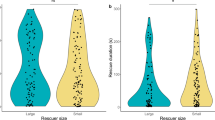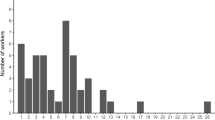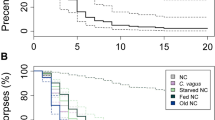Abstract
ANTS of the Formica rufa group often overlook suitable prey if it does not move1 and often attack insects not normally preyed upon if they perceive movement2. The following experiment was designed to obtain more accurate information on the role of prey movements in the searching behaviour of worker ants.
This is a preview of subscription content, access via your institution
Access options
Subscribe to this journal
Receive 51 print issues and online access
$199.00 per year
only $3.90 per issue
Buy this article
- Purchase on Springer Link
- Instant access to full article PDF
Prices may be subject to local taxes which are calculated during checkout
Similar content being viewed by others
References
Wellenstein, G., Z. angew. Entomol., 36, 185 (1954).
Nixon, C. E. J., Association of Ants with Aphids and Coccids, Comm. Inst. Entomol. (1951).
Author information
Authors and Affiliations
Rights and permissions
About this article
Cite this article
AYRE, G. Response to Movement by Formica polyctena Forst.. Nature 199, 405–406 (1963). https://doi.org/10.1038/199405b0
Issue Date:
DOI: https://doi.org/10.1038/199405b0
This article is cited by
-
The effect of predation risk on the predatory behaviour of a sit-and-wait predator,Ranatra dispar (Heteroptera: Nepidae), the water stick insect
Journal of Ethology (1986)
-
Transport de proies déposées sur une piste deFormica polyctena
Insectes Sociaux (1969)
Comments
By submitting a comment you agree to abide by our Terms and Community Guidelines. If you find something abusive or that does not comply with our terms or guidelines please flag it as inappropriate.



